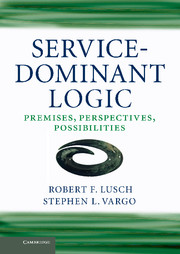Book contents
- Frontmatter
- Dedication
- Contents
- List of Exhibits
- Foreword
- Preface
- Acknowledgments
- Part I Premises
- Part II Perspectives
- 5 It’s all actor-to-actor (A2A)
- 6 The nature, scope, and integration of resources
- 7 Collaboration
- 8 Service ecosystems
- Part III Possibilities
- Appendix Reflection and dialogue
- Index
- References
6 - The nature, scope, and integration of resources
Published online by Cambridge University Press: 05 June 2014
- Frontmatter
- Dedication
- Contents
- List of Exhibits
- Foreword
- Preface
- Acknowledgments
- Part I Premises
- Part II Perspectives
- 5 It’s all actor-to-actor (A2A)
- 6 The nature, scope, and integration of resources
- 7 Collaboration
- 8 Service ecosystems
- Part III Possibilities
- Appendix Reflection and dialogue
- Index
- References
Summary
Exactly the same resource when used for different purposes or in different ways and in combination with different types or amounts of other resources provides a different service or set of services.
Edith Penrose (1959, p. 25)Introduction
Resource, as a concept used to discuss economic and social exchange, cuts across many disciplines. Service-dominant (S-D) logic views resources as what actors can draw on for support. Some resources are market facing, but many others are non-market facing; some are tangible, but many are intangible; some are internal to the actor, but many, if not most, are external to the actor; some are operand, but others are operant. Actors themselves are “operant resources” when they apply their resources (primarily knowledge and skills) to provide service to other actors. Service beneficiaries are also operant resources when they use their knowledge and skills to integrate other resources to cocreate value. This view of resources as linked to actors, service provision, and cocreated value offers a systems view of the role of resources in service exchange, actor-to-actor (A2A) networks, and human economic and social progress.
- Type
- Chapter
- Information
- Service-Dominant LogicPremises, Perspectives, Possibilities, pp. 119 - 135Publisher: Cambridge University PressPrint publication year: 2014

